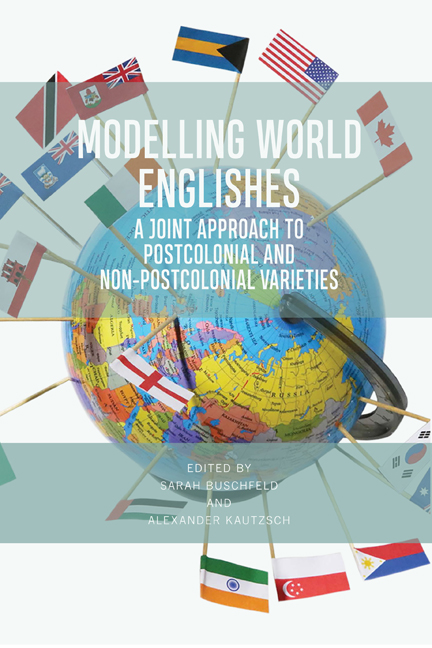Book contents
- Frontmatter
- Contents
- List of Figures and Tables
- List of Contributors
- Foreword
- 1 Introduction
- 2 English in England: The Parent Perspective
- 3 English in Namibia: Multilingualism and Ethnic Variation in the Extra- and Intra-territorial Forces Model
- 4 English in the United Arab Emirates: Status and Functions
- 5 English in India: Global Aspirations, Local Identities at the Grassroots
- 6 English in Singapore: Two Issues for the EIF Model
- 7 English in the Philippines: A Case of Rootedness and Routedness
- 8 English in South Korea: Applying the EIF Model
- 9 English in Japan: The Applicability of the EIF Model
- 10 English in Australia – Extra-territorial Influences
- 11 English in North America: Accounting for its Evolution
- 12 English in The Bahamas and Developmental Models of World Englishes: A Critical Analysis
- 13 Standard English in Trinidad: Multinormativity, Translocality, and Implications for the Dynamic Model and the EIF Model
- 14 Englishes in Tristan da Cunha, St Helena, Bermuda and the Falkland Islands: PCE, non-PCE or both? Blurred Boundaries in the Atlantic
- 15 English in Ireland: Intra-territorial Perspectives on Language Contact
- 16 English in Gibraltar: Applying the EIF Model to English in Non-Postcolonial Overseas Territories
- 17 English in Ghana: Extra- and Intra-territorial Forces in a Developmental Perspective
- 18 Synopsis: Fine-tuning the EIF Model
- Index
6 - English in Singapore: Two Issues for the EIF Model
Published online by Cambridge University Press: 24 September 2020
- Frontmatter
- Contents
- List of Figures and Tables
- List of Contributors
- Foreword
- 1 Introduction
- 2 English in England: The Parent Perspective
- 3 English in Namibia: Multilingualism and Ethnic Variation in the Extra- and Intra-territorial Forces Model
- 4 English in the United Arab Emirates: Status and Functions
- 5 English in India: Global Aspirations, Local Identities at the Grassroots
- 6 English in Singapore: Two Issues for the EIF Model
- 7 English in the Philippines: A Case of Rootedness and Routedness
- 8 English in South Korea: Applying the EIF Model
- 9 English in Japan: The Applicability of the EIF Model
- 10 English in Australia – Extra-territorial Influences
- 11 English in North America: Accounting for its Evolution
- 12 English in The Bahamas and Developmental Models of World Englishes: A Critical Analysis
- 13 Standard English in Trinidad: Multinormativity, Translocality, and Implications for the Dynamic Model and the EIF Model
- 14 Englishes in Tristan da Cunha, St Helena, Bermuda and the Falkland Islands: PCE, non-PCE or both? Blurred Boundaries in the Atlantic
- 15 English in Ireland: Intra-territorial Perspectives on Language Contact
- 16 English in Gibraltar: Applying the EIF Model to English in Non-Postcolonial Overseas Territories
- 17 English in Ghana: Extra- and Intra-territorial Forces in a Developmental Perspective
- 18 Synopsis: Fine-tuning the EIF Model
- Index
Summary
INTRODUCTION
Schneider's (2007) Dynamic Model (DM), which aims to provide an account of the development of postcolonial Englishes (PCEs), has proven to be extremely influential. The DM has made it possible to situate the various PCEs in relation to the five phases that it posits (foundation, exonormative stabilisation, nativisation, endonormative stabilisation and differentiation), thus connecting the developments of PCEs to their colonial histories as well as their later sociopolitical conditions. This also opens up ways of comparing the sociolinguistic trajectories of different PCEs, and even possibly to make predictions about their future developments given that the phases are ordered in a linear manner.
Despite its success, the DM does face two key issues, one internal to the model and the other external to it. The internal issue is this. There are developments in PCEs which go beyond the fifth phase of differentiation, such as the global mobility of peoples as well as cultural – including linguistic – products. The DM needs to address this issue of mobility because one of the key principles behind the DM is its consistency with macro-sociolinguistic processes (Schneider 2007: 20). This means that the model has to be able to establish connections with ongoing macro-sociolinguistic changes since the history of PCEs clearly does not end with the fifth phase. As Schneider himself acknowledges, ‘the glocalization of English will continue’ (2007: 317).
The external issue is this. There are observed similarities between PCEs and non-PCEs. Non-PCEs have been observed to display some of the features associated with PCEs, such as nativisation and second-language status (e.g. Edwards 2016). Unless these similarities are accounted for, the DM is in the awkward position where they have to be treated as coincidences.
The Extra- and Intra-territorial Forces Model (EIFM) (Buschfeld and Kautzsch 2017) attempts to address the external issue though not the internal one. It aims to address the external issue by arguing that both PCEs and non-PCEs develop along similar lines; that is, non-PCEs, too, present many of the same five phases identified by the DM. According to the EIFM, the two kinds of Englishes, PCEs and non-PCEs, differ mainly in whether their foundation phases involved a period of colonisation.
- Type
- Chapter
- Information
- Modelling World EnglishesA Joint Approach to Postcolonial and Non-Postcolonial Varieties, pp. 112 - 132Publisher: Edinburgh University PressPrint publication year: 2020



